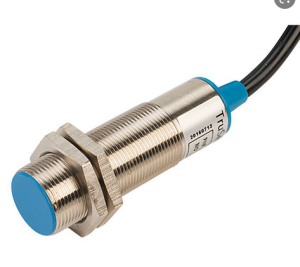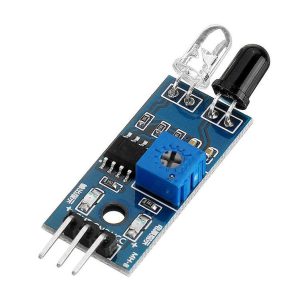
Proximity Sensors: Types, Working Principle and Applications
August 28 2023  1006
1006
Inquiry
Global electronic component supplier Ampheo Electronics: Rich inventory for one-stop shopping. Inquire easily, and receive fast, customized solutions and quotes.
QUICK RFQ
ADD TO RFQ LIST
In this blog, we will delve into the concept, types, working principle, and applications of proximity sensors to let readers have a better understanding of this knowledge.
What are Proximity Sensors?
Proximity sensors are devices used to detect the presence or absence of objects within a certain range without any physical contact. Proximity sensors can use different methods such as sound, light, infrared radiation (IR), or electromagnetic fields to detect a target, depending on their type. They are commonly used in various industries and applications, including manufacturing, automation, robotics, and consumer electronics. [caption id="attachment_155505" align="aligncenter" width="300"]
Proximity Sensors Types
There are several types of proximity sensors used in different applications. Here are some of the common types: Inductive Proximity Sensors: These sensors detect metallic objects by generating an electromagnetic field. When a metallic object enters the sensing range, it causes a change in the electromagnetic field, which is detected by the sensor. Inductive proximity sensors are widely used in industrial automation and robotics. Later I will fully explain the inductive proximity sensor. Capacitive Proximity Sensors: Capacitive sensors detect objects based on changes in capacitance. They generate an electrostatic field and measure the changes in capacitance caused by the presence of an object with a different dielectric constant. Capacitive proximity sensors can be used to detect both metallic and non-metallic objects and are often employed in object detection, level sensing, and touch-sensitive applications. Ultrasonic Proximity Sensors: Ultrasonic sensors use sound waves at frequencies above the human hearing range. They emit ultrasonic waves and measure the time it takes for the waves to bounce back after hitting an object. By measuring the time of flight, they can determine the distance to the object. Ultrasonic proximity sensors are commonly used in applications such as parking assistance, object detection, and distance measurement. Photoelectric Proximity Sensors: Photoelectric sensors use light beams to detect the presence or absence of objects. They consist of an emitter that emits a light beam and a receiver that detects the reflected light. When an object enters the sensing area and interrupts the light beam, the sensor detects the object. Photoelectric proximity sensors can be further categorized into two types: through-beam and retro-reflective. Through-beam sensors have separate emitter and receiver units, while retro-reflective sensors use a reflector to bounce the light back to the receiver. Magnetic Proximity Sensors: Magnetic sensors detect the presence of metallic objects by measuring changes in the magnetic field. They are commonly used in applications where the target objects are made of ferrous materials. Magnetic proximity sensors are often used in security systems, door and window position detection, and speed-sensing applications. [caption id="attachment_155507" align="aligncenter" width="300"]
Inductive Proximity Sensors Working Principle
Inductive proximity sensors work based on the principle of electromagnetic induction. They consist of a coil and an oscillator that generates a high-frequency electromagnetic field. When a metallic object enters the sensing range of the sensor, it interacts with this electromagnetic field, causing changes in the inductance of the coil. The working principle of inductive proximity sensors can be summarized in the following steps: Oscillator: The sensor's oscillator generates a high-frequency alternating current (AC) that passes through the coil. This creates an electromagnetic field around the coil. Sensing Range: The electromagnetic field extends from the coil and forms a sensing range in front of the sensor. The size of the sensing range depends on the specific sensor's design and can range from a few millimeters to several centimeters. Detection of Metallic Object: When a metallic object enters the sensing range, it affects the electromagnetic field generated by the coil. The presence of the metal object influences the inductance of the coil. Change in Inductance: The presence of the metal object causes a change in the inductance of the coil. This change is detected by the sensor's circuitry. Triggering the Output: Based on the change in inductance, the sensor's circuitry triggers the output. The output can be in the form of a switch, which changes state (ON/OFF) when a metal object is detected, or an analog signal that provides information about the proximity of the object. It's important to note that inductive proximity sensors can detect only metallic objects. Non-metallic materials such as plastic, wood, or liquids do not significantly affect the electromagnetic field and, therefore, are not detected by these sensors. Inductive proximity sensors are widely used in various industrial applications for object detection, presence sensing, and automation purposes. They offer non-contact detection, high reliability, and resistance to harsh environments, making them suitable for diverse industrial settings.How do Proximity Sensors Work?
Proximity sensors work based on various principles, depending on their type. However, the common goal of all proximity sensors is to detect the presence or absence of an object without physical contact. Here is a general overview of how proximity sensors work: Emitting a Signal: Proximity sensors emit a signal, such as electromagnetic waves, sound waves, or light beams, depending on the sensor type. The emitted signal creates a field or cone-shaped area around the sensor. Interaction with an Object: When an object enters the field or interrupts the signal, it interacts with the sensor in some way. The specific interaction varies based on the type of proximity sensor being used. Detection of the Change: The proximity sensor detects the change caused by the presence or absence of the object. This change can be a variation in capacitance, inductance, light intensity, sound reflection, or another measurable parameter. Triggering the Output: Once the change is detected, the proximity sensor triggers an output. This output can be in the form of an electrical signal, a state change (ON/OFF), an analog value, or a digital signal. Signal Processing: In some cases, the proximity sensor's output may require further processing or interpretation. This can involve amplification, filtering, or conversion of the signal to a more usable format for the intended application. The specific working principle of a proximity sensor depends on its type, which can include inductive, capacitive, ultrasonic, optical, or magnetic sensors, among others. Each type has its unique way of detecting objects and providing output based on their proximity. It's important to consider the application requirements when selecting a proximity sensor. Factors such as sensing range, object material, environmental conditions, and the required output type should be taken into account to ensure the sensor's effectiveness in the intended application. Overall, proximity sensors provide a non-contact and efficient means of detecting objects in various industries, including manufacturing, automation, robotics, automotive, and consumer electronics.How to Test Proximity Sensors?
Testing proximity sensors is essential to ensure their proper functioning and accuracy. Here are some common methods for testing proximity sensors: Visual Inspection: Start by visually inspecting the proximity sensor for any visible damage or loose connections. Ensure that the sensor is clean and free from any debris or obstructions that could affect its performance. Functionality Test: Use an object that should trigger the proximity sensor and bring it within the specified sensing range. Observe whether the sensor detects the object and triggers the desired output, such as an LED indicator or a change in state (ON/OFF). Sensing Range Test: Test the proximity sensor's sensing range by gradually moving an object closer to the sensor until it triggers the output. This helps determine the effective range and ensures that the sensor can detect objects within the specified distance. Response Time Test: Check the response time of the proximity sensor by moving an object back and forth in front of the sensor. Observe how quickly the sensor detects the presence or absence of the object and triggers the output. The response time should be within the specified limits. Ambient Conditions Test: Test the proximity sensor under different ambient conditions that it may encounter in its intended application. This includes varying lighting conditions, temperature ranges, humidity levels, and electromagnetic interference (EMI). Ensure that the sensor performs reliably and accurately in different environments. Calibration Test: Some proximity sensors may require calibration to adjust their sensitivity or threshold. Follow the manufacturer's instructions to calibrate the sensor properly. This may involve adjusting potentiometers or using calibration tools provided by the manufacturer. Comparative Testing: If possible, compare the readings or outputs of the proximity sensor with a known working sensor of the same type. This helps identify any inconsistencies or deviations in performance. Documentation and Standards Compliance: Verify that the proximity sensor meets the required standards and specifications for the intended application. Check the sensor's documentation or datasheet for information on standards compliance, accuracy, and performance characteristics. It is important to refer to the manufacturer's guidelines and specifications for specific testing procedures and requirements for the proximity sensor being used. Additionally, follow safety precautions and guidelines while testing proximity sensors, especially in industrial or high-voltage applications.Proximity Sensors Applications
Proximity sensors find applications in various industries and sectors due to their ability to detect the presence or absence of objects without physical contact. Here are some common applications of proximity sensors: Object Detection: Proximity sensors are widely used for object detection in industrial automation and robotics. They can detect the presence or absence of objects on conveyor belts, assembly lines, and robotic arms, enabling precise control and automation of processes. Material Handling: Proximity sensors play a crucial role in material handling systems, such as automated warehouses and logistics. They can detect the presence of packages, pallets, or containers, ensuring accurate sorting, tracking, and movement of materials. Security Systems: Proximity sensors are used in security systems to detect the presence of intruders or unauthorized individuals. They can be integrated into access control systems, motion detectors, and burglar alarms to trigger alarms or activate security measures. Automotive Applications: Proximity sensors are extensively used in the automotive industry. They are employed in parking assist systems, collision avoidance systems, and adaptive cruise control systems to detect obstacles or other vehicles, providing driver assistance and enhancing safety. Proximity Switches: Proximity sensors are often used as proximity switches in various applications. For example, machine tools can be used to detect the position of moving parts, such as the presence of a workpiece or the end of a stroke. Liquid Level Sensing: Capacitive proximity sensors are commonly used for liquid level sensing in tanks and containers. They can detect the presence of liquids, such as water or chemicals, without direct contact, allowing for accurate level monitoring and control. Touchless Interfaces: Proximity sensors are employed in touchless interfaces, such as automatic doors in public buildings, elevators, and touchless faucets. They detect the presence of a person or hand gesture, triggering the desired action without physical contact. Mobile Devices: Proximity sensors are integrated into mobile devices like smartphones and tablets. They can detect the proximity of the user's face during a call, automatically turning off the screen to prevent accidental touches and save power. Robotics: Proximity sensors are used in robotics applications to detect the proximity of objects or other robots. They enable collaborative robots (cobots) to work safely alongside humans by detecting their presence and avoiding collisions.Conclusion
In conclusion, proximity sensors are vital components used in various industries. They come in different types, such as inductive, capacitive, and photoelectric sensors, each with its working principle. These sensors enable automation, enhance safety, and improve efficiency in applications like manufacturing, automotive, and security systems. Proximity sensors offer non-contact detection, accuracy, and reliability in harsh environments. Understanding their types, working principles, and applications helps industries make informed decisions. Proximity sensors continue to play a crucial role in modern technology.Populer Posts
